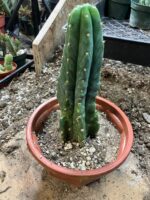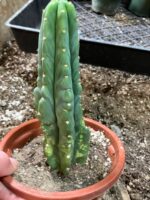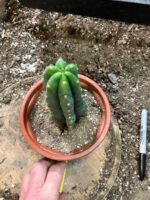New






The San Pedro cactus (Trichocereus pachanoi) is one of the most extraordinary sacred plants on earth, admired for its rapid growth, imposing size, and centuries-old spiritual legacy. At 7 feet tall, this specimen represents a fully matured cactus, making it a stunning centerpiece for collectors, gardeners, and enthusiasts of ethnobotanical treasures.
San Pedro is a columnar cactus known for its smooth, ribbed body and vibrant green color. While young plants are compact and manageable, a 7-foot San Pedro showcases its true majesty. Its vertical growth gives it an impressive presence, making it one of the most ornamental cacti for outdoor landscapes, greenhouses, or large collections.
With proper care, Trichocereus pachanoi can grow even taller, sometimes reaching 12–20 feet in height in its native Andes. Owning a 7-foot cactus means having a plant that has thrived for many years, embodying both strength and longevity.
San Pedro is not only admired for its looks but also for its reputation as a psychedelic cactus. Containing the entheogenic alkaloid mescaline, Trichocereus pachanoi has been used in shamanic rituals, healing practices, and vision quests for over 3,000 years.
Unlike recreational substances, San Pedro is regarded as a plant teacher—a cactus that provides guidance, wisdom, and introspection. Participants in ceremonial use often report heightened perception, vivid visuals, altered sense of time, and deep emotional or spiritual insights.
Because of this, San Pedro continues to be a sacred cactus for Indigenous peoples of Peru, Ecuador, and Bolivia, where it is often referred to as Huachuma or Achuma.
The name San Pedro was given by the Spanish during colonization, linking the cactus to Saint Peter, the keeper of the keys to heaven. For Indigenous shamans, however, the cactus was already revered as a bridge between the physical and spiritual worlds.
Traditionally, San Pedro ceremonies are performed to cleanse negative energies, encourage healing, and open the heart. Many still view the cactus as a guide for personal transformation, compassion, and enlightenment.
While smaller San Pedro plants are more common, a 7-foot cactus is a rare acquisition due to the many years it takes to reach this height. Such a specimen demonstrates not only the cactus’s resilience and vitality but also the patience of its grower.
Mature Growth – At 7 feet, this cactus has already reached impressive size.
Fast Growing – Unlike Peyote, San Pedro continues to expand steadily each year.
Ornamental Impact – Perfect as a focal point in large gardens or collections.
Sacred Heritage – A living piece of Andean tradition and spiritual history.
Ethically Cultivated – Sustainably grown, never taken from the wild.
Owning such a plant is like holding a piece of living history—a cactus that has stood the test of time while maintaining its beauty and sacred importance.
Despite its impressive size, San Pedro remains a relatively low-maintenance cactus.
Light – Prefers full sun to partial shade.
Soil – Well-draining soil mix with sand or pumice.
Watering – Water moderately during growth season, reduce in winter.
Climate – Hardy in warm, dry conditions but can adapt to various environments.
Because of its adaptability, San Pedro is a suitable cactus even for growers outside its native Andean habitat.
This San Pedro cactus – Trichocereus pachanoi – 7 feet tall is an extraordinary plant for serious collectors. Combining ornamental beauty, cultural depth, and spiritual symbolism, it stands out as one of the most meaningful cacti you can own.
Whether admired as a sacred entheogen, a living symbol of Andean tradition, or simply as a striking ornamental cactus, San Pedro remains a timeless treasure.
Bring the power, beauty, and heritage of San Pedro into your collection today with this rare 7-foot cactus specimen.
$36.99
Payment Methods:
The San Pedro Cactus (Trichocereus pachanoi) is one of the most powerful and well-known psychedelic plants in the world. This sacred cactus contains the naturally occurring hallucinogenic compound mescaline, which is responsible for its visionary and transformative effects. For thousands of years, Indigenous cultures in the Andes have valued San Pedro not only as a healing plant but also as a spiritual guide, using it in rituals and ceremonies to promote self-discovery, clarity, and connection to higher realms.
Long before modern interest in entheogens, the San Pedro cactus was revered by Indigenous peoples of Peru and Ecuador. Traditionally known as Achuma or Huachuma, the cactus was used by shamans and healers to treat ailments, cleanse negative energies, and induce visionary states.
When the Spanish colonizers arrived, they renamed the cactus “San Pedro,” or Saint Peter, symbolizing the biblical figure who held the keys to heaven. For them, the plant was considered sacred, a doorway to spiritual knowledge and divine experiences.
The cactus grows naturally in the highlands of South America, typically flourishing at altitudes between 2,000 and 3,000 meters, where the climate is ideal for its strong and resilient growth. Today, it is cultivated and appreciated worldwide as both a sacred cactus and a remarkable botanical specimen.
San Pedro Cactus is famous as a mescaline cactus. Mescaline is a powerful psychoactive alkaloid that has been used by humans for thousands of years, making it one of the oldest known psychedelic substances on Earth. Unlike synthetic drugs, mescaline from San Pedro is a natural entheogen, used in spiritual and healing traditions to expand consciousness and promote inner growth.
The effects of San Pedro mescaline are profound and often transformative. Many users describe it not as a recreational drug but as a teacher plant—a natural medicine that provides wisdom, healing, and self-understanding.
While smaller San Pedro plants are more common, a 7-foot cactus is a rare acquisition due to the many years it takes to reach this height. Such a specimen demonstrates not only the cactus’s resilience and vitality but also the patience of its grower.
Mature Growth – At 7 feet, this cactus has already reached impressive size.
Fast Growing – Unlike Peyote, San Pedro continues to expand steadily each year.
Ornamental Impact – Perfect as a focal point in large gardens or collections.
Sacred Heritage – A living piece of Andean tradition and spiritual history.
Ethically Cultivated – Sustainably grown, never taken from the wild.
Owning such a plant is like holding a piece of living history—a cactus that has stood the test of time while maintaining its beauty and sacred importance.
The experience with San Pedro Cactus varies, but users often report powerful psychological, sensory, and spiritual effects. These may include:
Altered perception of reality – The world appears brighter, more colorful, and alive.
Enhanced visual experiences – Objects may distort, glow, or emit light.
Distortion of time and space – Time may feel slower, faster, or completely suspended.
Heightened sensory perception – Sounds, textures, and images blend together (synesthesia).
Emotional sensitivity – Deeper connection to personal feelings and those of others.
Spiritual and mystical insights – A sense of unity, transcendence, and connection to the divine.
Self-reflection and life lessons – Mescaline often acts as a mirror, revealing hidden truths or unresolved issues.
Healing potential – Many report releasing trauma, gaining clarity, and addressing deep-seated challenges.
Because of these effects, San Pedro is considered a sacred medicine rather than a recreational hallucinogen. Its purpose is often seen as teaching, healing, and guiding.
For Indigenous shamans, San Pedro is a plant ally, a bridge between the human and spiritual worlds. In ceremonies, it is used to bring harmony, restore balance, and guide participants through visions of personal and universal truth. Many believe that the cactus helps open the heart, encouraging compassion, forgiveness, and deeper wisdom.
This is why San Pedro remains one of the most important sacred plants in Andean culture and has now spread globally as a symbol of spiritual exploration, healing, and enlightenment.
Beyond its psychoactive significance, San Pedro is also admired as a fast-growing and resilient cactus. Unlike the small and slow-growing Peyote, San Pedro Cactus quickly reaches impressive heights, making it popular among cactus collectors, gardeners, and enthusiasts of sacred plants. Its smooth columnar body and vibrant green color make it an attractive addition to any cactus collection.
For those passionate about ethnobotany, entheogenic plants, and spiritual traditions, San Pedro offers a unique combination of cultural history, psychoactive power, and botanical beauty.
The San Pedro cactus (Trichocereus pachanoi) is far more than just a plant. It is a living link to ancient cultures, a source of profound psychedelic experiences, and a sacred teacher for those who approach it with respect. Whether admired as a collector’s cactus, a spiritual ally, or a natural hallucinogen, San Pedro continues to be one of the most extraordinary and meaningful plants in the world.
No account yet?
Create an Account